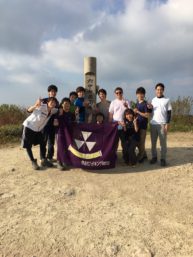My experience with the Community Involvement Project has afforded me the opportunity to witness two phenomenon which, I believe, are equally common, but which are opposite in nature: timidity versus openness towards foreigners. Having participated in two different CIP activities during my time at KCJS, I feel that I can say with a fair degree of confidence that I’ve seen two sides of the same coin, and that the difference in my treatment in each setting had a significant impact on my enjoyment of the CIP activity as a whole.
To begin, I initially set out to join Doshisha University’s Ping-Pong Circle. I’ll confess that I don’t have much experience playing ping-pong, despite being somewhat competitively intrigued by it in my high school days, and so for the Japanese students who were already in the club – and who appeared to take their practice of ping-pong very seriously – playing with me must have been extremely frustrating. That being said, apart from their apparent unwillingness to step up to whichever table I’d staked out, I experienced a further unwillingness to even engage in conversation. Despite multiple attempts to get to know my fellow club members, to learn more about their club and its members, etc., my attempts to start conversations were repeatedly shut down by their mere unwillingness to provide me with answers.
Interestingly, while this experience certainly sheds some light on the degree of comfort these students have interacting with foreigners, Joey Ye – who joined the club before I did, and who was at a similar skill level as I was – didn’t seem to have much of a problem interacting with the club members. Thus, I couldn’t help but wonder – was their unwillingness to interact with me also because I’m a woman? I did notice that female members of the Ping-Pong Circle seemed few and far between, and it occurred to me that potentially, my being a foreigner was not the only source of hesitation that the Doshisha students felt in interacting with me.
Unfortunately, after several weeks of repeated, failed attempts at making conversation, I came to the conclusion that perhaps the Ping-Pong Circle was not the right CIP for me. Given that the goal of CIP participation is to involve oneself in the community, I felt that rather than being involved, I was more being made to observe – regardless of my own desire to be more engaged in my activity. Feeling that I might strike better luck with a group of people with whom I had more in common, I ultimately made the decision to leave the Ping-Pong Circle in pursuit of another activity: participation in the anime club.
It was here that I found myself truly enjoying my CIP activity. The response that I received from the members of the anime club was, in almost every way, different from the response I received from the members of the Ping-Pong Circle. I was welcomed enthusiastically into the anime club, apologized to repeatedly for some minor inconveniences surrounding my membership fee, and spoken to often and willingly by the various members who would come and go without, it seemed, adherence to a strict schedule. Rather than gathering together for the purpose of cultivating a specific skill, the members of the anime club seemed to be more a group of friends who found enjoyment in one another’s company than anything else.
Although I will confess that my language skills – or lack thereof – prevented me from engaging with the members on an especially deep level, I found that they were more than willing to help me get my membership fee squared away, figure out a schedule for coming and going, helping me read various kanji, etc. In the instances that I experienced a lack of communication with the club members, the reason seemed sourced more in lack of ability than lack of desire.
Ultimately, I’ve found that my experience with the anime club has been entirely pleasant, and I am glad that I was able to find a CIP in which I felt more comfortable. While I certainly am not able to make any sociological generalizations based on my experience, again, I feel that I can accurately summarize the difference in my experiences by pointing out the different attitudes held by Doshisha students toward interacting with foreigners. While one is neither better nor worse, right nor wrong, I will admit that after my experience in the Ping-Pong Circle, I will absolutely go out of my way to interact more with foreign exchange students at my home university. Because although I have finally found a setting in which I feel more comfortable, that initial experience of discomfort was a bit disheartening.



